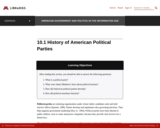
This lesson understand political parties and their origins.
- Subject:
- History
- U.S. History
- Material Type:
- Reading
- Textbook
- Author:
- University of Minnesota
- Date Added:
- 12/10/2021

This lesson understand political parties and their origins.

For many students, a trip to Washington, D.C. is a once-in-a-lifetime experience that opens their eyes to an exciting world beyond their classrooms. Discovery Education and First Lady Dr. Jill Biden welcome students to a behind-the-scenes Virtual Field Trip to experience the history and beauty of our nation’s capital.
Designed for students in grades 4-8, this action-packed tour features remarkable special guests and give viewers an inside look at six landmark locations:
The White House
The U.S. Capitol Building
The Supreme Court
The Martin Luther King, Jr. Memorial
Arlington National Cemetery and the Tomb of the Unknown Soldier
The Smithsonian National Air and Space Museum
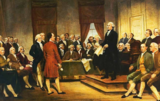
This activity is designed to help students understand the debates at the Constitutional Convention in 1787 that shaped America’s legislative branch of government. The primary goal of this activity is for students to discover how a compromise balanced the needs of large states and small states and how this led to the creation of the current House of Representatives and Senate.
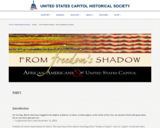
Freedom for some meant slavery for others. The cruel irony of this nation’s founding and its “Temple of Liberty”—the U.S. Capitol—is that both were made possible by the enslavement of African Americans.
The labor of enslaved and free blacks helped build the Capitol. An enslaved African American man helped to cast the Statue of Freedom, which was placed atop the Dome during the Civil War.
Since the end of the Civil War, African Americans have struggled to move out of the shadows and into the Temple of Liberty as full participants.
This the online version of a traveling exhibit by the U.S. Capitol Historical Society that depicts the journey of African Americans from slavery to freedom and political representation in the U.S. Capitol. The exhibit opened February 2006 in Baltimore, Maryland at the Reginald F. Lewis Museum of Maryland African American History and Culture.
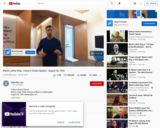
I Have a Dream Speech. Martin Luther King's Address at March on Washington, August 28, 1963. Washington, D.C.

A collection of materials provided by Nancy Long to celebrate Florida's new statue of Mary McLeod Bethune in the U.S. Statuary Hall Collection 2022.
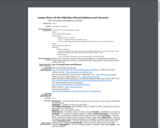
In this lesson, students will explore the biography of Mary McLeod Bethune and primary resources related to her life in order to understand the impact she had on other people, and how her example of integrity and principle can affect their own lives today.

This activity “Becoming aware of the Japanese American Internment Camp Experience” is intended to help students become aware of, and sensitive to, the Japanese American interment camp experience. They will develop a sense of empathy by simulating the situations which Japanese American children faced.
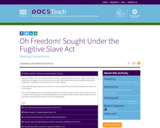
The road to Emancipation was indeed stony! Enslaved people struggled to free themselves and loved ones, one person at a time.
This activity includes primary sources from the official records of the U.S. District Court at Boston that tell the story of William and Ellen Craft, a young couple from Macon, GA, who escaped to freedom in Boston in 1848. The two traveled together, Ellen as a White gentleman (she was the daughter of an African-American woman and a White master and passed as White), and William as her slave valet. They made their way to Boston, and lived in the home of Lewis Hayden, a former fugitive and abolition activist.
With the passing of the Fugitive Slave Act in September, 1850, the Crafts' respective owners employed the legal system to regain their escaped property. A U.S. Marshal was sent to the home of Lewis Hayden. Hayden refused to let the marshal in and threatened to ignite kegs of gunpowder; the Marshal left. Ellen and William fled to Britain, where they remained for 20 years. They eventually returned to the United States and settled back in Georgia.
In this activity, students will examine historic documents about these fugitives from slavery. Then, using the documents, they will construct historical narratives to tell their story. They can explore perspective and use standard elements of writing (plot, character, setting, conflict, impact). Thinking about essential questions/topics, they will begin their writing with a topic/opening sentence that sets out the main idea.
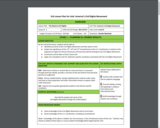
By the end of this lesson, students will be able to:
● Identify key events of the Civil Rights Movement and their place in time
● Explain the significance of the 13th, 14th and 15th Amendments to the U.S. Constitution in relation to the
expansion of rights for African Americans and how they laid the footing for the Civil Rights Movement
● Summarize central ideas of short, dense text
● Apply Tier 2/academic and Tier 3/domain-specific vocabulary associated with the Civil Rights Movement

Although many people think of the White House as a symbol of democracy, it is also a part of our country’s history of slavery. From the start of White House construction in 1792 until emancipation took effect in Washington, D.C. in 1862, enslaved men, women, and children labored at the Executive Mansion. The stories of these individuals, working under the oppressive institution of slavery in the “People’s House,” demonstrate a stark contrast to the ideals of freedom and democracy that the White House has long represented.
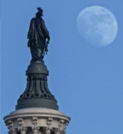
Atop the Dome of the U.S. Capitol stands a statue more than 19 feet tall, cast in bronze. Her name is Freedom. American artist Thomas Crawford sculpted Freedom from plaster at his studio in Rome, Italy. Crawford created three designs. The statue was shipped across the ocean in five pieces and assembled by an Italian craftsman for temporary display on the Capitol grounds. Then the pieces were to be taken apart and cast into bronze.The U.S. government hired Clark Mills, who owned a foundry in Washington, D.C., to make the bronze castings. A foundry is a factory where metal is melted for casting. However, the artist who assembled Freedom covered the seams between the five pieces in plaster, hiding them from view. He refused to take his work apart unless he received a pay raise. Only one man knew what to do. His name was Philip Reid.
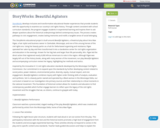
StoryWorks develops inclusive and transformative educational theater experiences that provide students with the opportunity to examine our country’s civil rights history. Through content consistent with school curriculum standards, the program engages students in experiential learning and inspires them to ask deeper questions about the historical underpinnings behind contemporary issues. The process creates pathways to civic engagement, creates lasting memories and instills a tangible sense of social belonging. This StoryWorks educational project is built around Beautiful Agitators, a theatrical play about Vera Mae Pigee, a hair stylist and business owner in Clarksdale, Mississippi, and one of the unsung heroes of the civil rights era. Using her beauty parlor as a hub for Delta-based organizing and resistance, Pigee operated her salon by day and then transformed it into a clandestine center for civil rights organization and education in the evenings. Known for her big hats and larger than life personality, Mrs. Pigee led the direct action that registered nearly 6,000 African Americans to vote in the region. Although Pigee was largely left out of the history books, along with many women of the movement, our play Beautiful Agitators and accompanying curriculum revives her legacy, highlighting her methods and tactics. Inspired by the innovative K-12 civil rights education standards developed by the Mississippi Civil Rights Commission. Our commitment is to expand upon the standards by further developing content related to social justice, power relations, environmental justice, diversity, equity, mutual respect, and civic engagement. Beautiful Agitators combines inquiry with higher-order thinking skills of analysis, evaluation and synthesis. Set in a beauty parlor owned and operated by a Black woman in the Mississippi Delta, our curriculum is based on our investigation into primary sources and their relationship to critical moments in the national movement. This foundation of historical context allows for students and educators to find contemporary parallels which further engage learners to reflect upon the legacy of the civil rights movement and the struggles that we, as citizens, continue to grapple with today.View the complete play Beautiful Agitators on the StoryWorks Theater site.Implementation1. Beautiful Agitators Performance Classroom watches a prerecorded, staged reading of the play Beautiful Agitators, which was created and performed by artists from the Mississippi Delta, home of Vera Mae Pigee.2. Lesson Plan Activities Following the eight-lesson plan structure, students will read aloud or act out scenes from the play. This participatory interaction with the text and the historical events promotes a high level of engagement from the students and encourages experiential learning. These activities directly correspond to scenes in the play and to specific content area standards. Teacher leads guided discussions and helps to explain the historical context and theme of each scene. Students/actors have the opportunity to share their experiences having portrayed these historical figures.

Through the play Beautiful Agitators and accompanying curriculum, students will eplore the life of Vera Mae Pigee and the role of women in the civil rights movement.

Through the play Beautiful Agitators and accompanying curriculum, students will eplore the life of Vera Mae Pigee and the impact of voter supression.

Through the play Beautiful Agitators and accompanying curriculum, students will eplore the life of Vera Mae Pigee and the impact of voter supression.
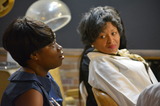
Through the play Beautiful Agitators and accompanying curriculum, students will eplore the life of Vera Mae Pigee and the role of the youth activism in the civil rights movement.
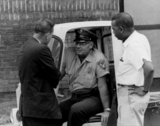
Through the play Beautiful Agitators and accompanying curriculum, students will eplore the life of Vera Mae Pigee and the power and influence of the Mississippi Sovereignty Commission.

Through the play Beautiful Agitators and accompanying curriculum, students will eplore the life of Vera Mae Pigee and the struggle to pursue nonviolent resistance.